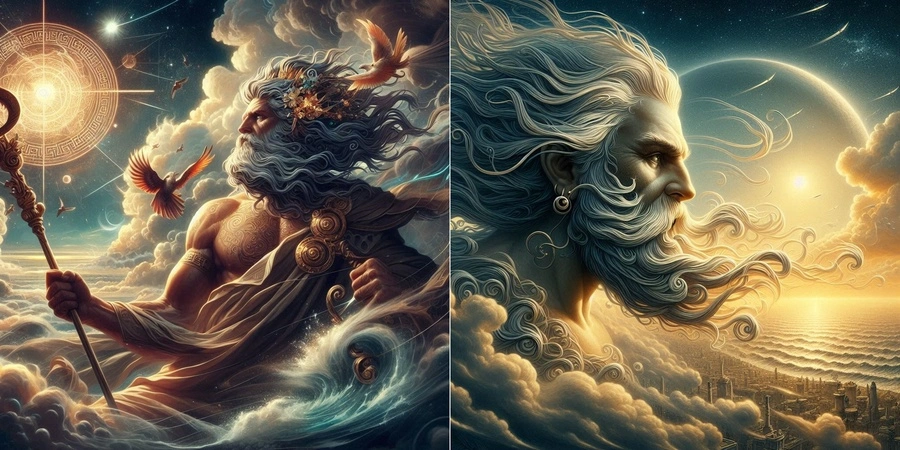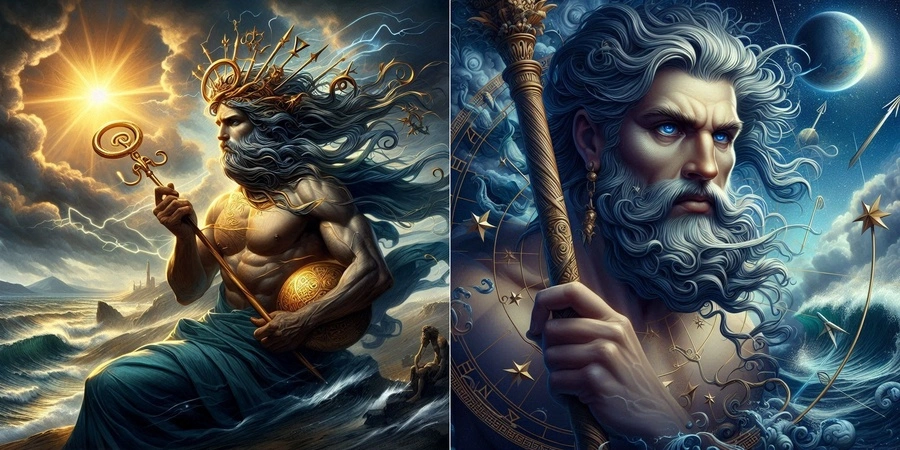
Eurus is one of the four wind gods and is associated with the east wind. He is often depicted as a gentle and temperate figure, and is known for his ability to bring warmth and light to the world. While Eurus does not play as prominent a role in Greek mythology as some of the other wind gods, he is still an important figure in ancient Greek culture.
The Story of Eurus
Eurus was known for his gentle and temperate nature, and was often associated with the warmer winds of spring and early summer. He was believed to bring new life to the world, and was sometimes associated with the season of growth and renewal.
Eurus is the son of the Titans Astraeus and Eos, who were associated with the stars and the dawn, respectively. Eurus was thus born into a family of powerful and influential deities.
Despite his gentle nature, Eurus was still a powerful and important figure in Greek mythology. He was believed to be one of the four wind gods who were responsible for shaping the natural world and the lives of mortals. His role as the god of the east wind further emphasized his connection to the rising sun and the promise of a new day.
Origins and Lineage
Eurus’ origins lie with Aeoeus, the titan who kept the winds imprisoned on the island of Aeolia. When freed by Zeus, the four cardinal winds, including Eurus, became known as the Anemoi. Eurus, however, held a somewhat contentious position. While most depictions portray him as the embodiment of the east wind, some sources claim him as the southeast wind, with Apeliotes taking the role of the true east. This inconsistency reflects the very nature of the east wind – a transitional force between the calm of the night and the fury of storms.
Unlike the other Anemoi who are easily visualized, Eurus’ artistic representations are scarce. The Tower of Winds in Athens, a monument dedicated to the eight winds, depicts Eurus as a powerful figure holding a heavy cloak, possibly symbolizing the weight of the impending storm he carries. In some literary descriptions, he appears as a hot, dry wind, a stark contrast to the rain-bringing Notos. This duality adds another layer of complexity to Eurus’ character.
Despite his elusiveness, Eurus played a significant role in several Greek myths. In the Homeric hymn to Apollo, Eurus is credited with saving Sparta by dispersing a plague-carrying mist. This act portrays him as a benevolent force, a bringer of renewal. However, Eurus’ power could also be destructive. In the epic poem Dionysiaca by Nonnus, Eurus is depicted as a hot wind closely associated with Helios, the sun god. Together, they unleash scorching heat upon the land. This association with the scorching sun paints Eurus as a potentially destructive force.

The ambiguity surrounding Eurus extends to his temperament. Unlike Boreas, the blustery north wind, or Zephyros, the gentle west wind, Eurus lacks a defining personality. He can be a life-giving breeze, ushering in the dawn and clearing the air, or a harbinger of chaos, bringing unpredictable storms and scorching heat. This unpredictability aligns perfectly with the east wind itself, a force that can be both refreshing and destructive.
Eurus’ marginalization in some myths might be due to the very nature of the east in Greek thought. The east was often seen as the realm of the unknown, the land beyond the horizon. Unlike the well-established north, south, and west, the east represented the unexplored, a space where dangers lurked alongside potential discoveries. Perhaps Eurus, as the embodiment of this unknown, remained undefined, reflecting the very mystery he carried.
The Symbols of Eurus in Greek Mythology
One of the most common symbols associated with Eurus is the image of the rising sun or a sunrise. This image emphasizes his connection to the east and his ability to bring warmth and light to the world. In many depictions, Eurus is shown holding aloft a torch or a light, which symbolizes the power of his wind to dispel darkness and bring hope to the world.
Another symbol of Eurus is the image of a gentle breeze blowing through fields or gardens. This image emphasizes his connection to growth and renewal, and underscores the role that he played in shaping the natural world. In some depictions, Eurus is shown surrounded by flowers or blooming trees, highlighting his association with spring and the season of new beginnings.
Eurus is also associated with a range of other symbols in Greek mythology, including the color green, which is often used to represent the lush growth that his wind brings to the world. Other symbols associated with Eurus include birds, which are seen as symbols of freedom and mobility, and the lyre, which is associated with music and harmony.

10 Myths and Facts About Eurus
Myths:
- A Contested Birthright: While most myths credit Aeoeus, the titan of the winds, as Eurus’ father, some suggest a more contentious origin. A fragment of the lost epic, Cypria, hints at Eurus being the offspring of Astraeus, the titan of the stars and dusk, and Eos, the goddess of dawn. This alternate lineage connects Eurus to both the fading darkness and the approaching dawn, further emphasizing his association with the transitional nature of the east.
- The Jealous Gatekeeper: A lesser-known myth portrays Eurus as the jealous guardian of the sunrise. Fearing the beauty of the rising sun might eclipse his own domain, Eurus would unleash sudden storms to delay the dawn. This myth offers a glimpse into a potentially destructive side of Eurus, one driven by envy rather than the natural order.
- The Horse Whisperer of Thrace: Thracian folklore whispers of Eurus’ connection to horses. He was believed to be particularly fond of the wild Thracian steeds, known for their speed and ferocity. Some myths depict him as guiding these horses across the sky, creating the very winds he personified. This association links Eurus to untamed power and swiftness, reflecting the unpredictable nature of the east wind.
- The Bringer of Spring Rains: In some agricultural communities, Eurus wasn’t solely associated with the hot, dry wind. He was also seen as a carrier of spring rains, crucial for nourishing the crops. This seemingly contradictory role reflects the complex nature of the east wind, which can bring both destruction and life-giving moisture.
- The Abductor of Aethon: A regional myth whispers of Eurus’ abduction of Aethon, one of the fiery horses that pulled the chariot of Helios, the sun god. This tale, though obscure, hints at a potential rivalry between Eurus and Helios, perhaps over their shared domain of the eastern sky.
Facts:
- The Eurus Constellation: While Eurus lacked a prominent role in Greek art, there’s evidence of an “Eurus” constellation mentioned by the astronomer Hipparchus. Its exact location and composition remain unclear, lost to the sands of time. This lost constellation offers a tantalizing glimpse into a more established role for Eurus in ancient astronomy.
- The Etymological Connection: The name “Eurus” likely originates from the Proto-Indo-European root “h₁ews-,” meaning “dawn” or “east.” This linguistic connection reinforces Eurus’ association with the rising sun and the eastern horizon.
- The Tower of the Winds Omission: The iconic Tower of the Winds in Athens depicts eight wind deities, but Eurus is curiously absent. This omission might be due to the prevailing southeast wind in Athens, making Apeliotes, the god of the southeast wind, a more relevant deity. Alternatively, it could reflect Eurus’ ambiguous role, not easily categorized within the established eight winds.
- The Inconstant Ally: Unlike his brother Zephyros, the gentle west wind, or Notos, the rain-bringer, Eurus wasn’t a reliable ally. Sailors often viewed him with trepidation, as his winds could quickly shift from gentle breezes to destructive storms. This unpredictability solidified Eurus’ reputation as a force of nature to be respected, if not entirely trusted.
- The Literary Legacy: While overshadowed by other wind gods, Eurus found mentions in various literary works. Virgil, in his epic Aeneid, describes Eurus as a “destructive wind,” while Ovid, in his Metamorphoses, portrays him as a “whistling wind.” These mentions, though brief, provide valuable insights into how Eurus was perceived in Roman and Greek literature.